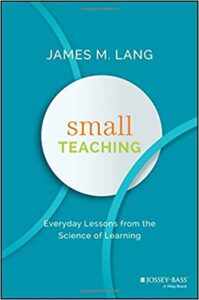Big Idea: Small frequent low stakes testing improves retrieval and learning
Part 1 of Small Teaching focuses on how learners acquire knowledge – how they retrieve understand, and predict information that is foundational to higher order critical thinking skills. As educators, we often focus on the application and synthesis of information without giving attention to how we support learners in building foundational knowledge.
This first chapter takes a closer look at the retrieval process and the importance of actively practicing retrieval through testing or quizzing to improve learning. This is known as the retrieval effect or testing effect. Answering questions about the learning content results in better retrieval than just re-studying the material. This retrieval practice is where learning happens.

CCO photo by Burak K from pexels.com
Think about learning to drive. Reading about driving isn’t sufficient to master driving; much of the learning happens when you practice driving.
The same principle applies to learners. For example, students spend much of their studying time by reading but little time testing their knowledge. This quizzing can be a powerful tool to enhance learning. Lang suggests that if we want to support students’ ability to retrieve information and optimize learning then we have to help students practice retrieval. Three key principles guide retrieval practice.
Principles
- Frequency Matters
- Regular quizzing results in greater improvement than sporadic testing
- Align Practice and Assessment
- Learners need to practice what they are going to retrieve
- Retrieval process requires thinking to be effective
- More complex questions helps improve retrieval
Retrieval is easy; Encoding is difficult
Much of the chapter concerns getting information out (retrieval) as opposed to getting information in (encoding). I diverge slightly from the book’s emphasis on retrieval as a barrier to learning. Retrieval is easy if information has been encoded in the first place.

CCO photo by Rachel Hall
I often use the following example with my students based on the work of Richardson (1993). Without looking, draw the opposite side of this Canadian nickel.
Many people can recall that a nickel has an image of a beaver and the words 5 Cents. But what else? Does it have other images or dates? Take a look and see how well you did. Interestingly, very few people can successfully draw a nickel from memory. Why is that? People encode what they pay attention to and what is important to them. In this case, the fact that a nickel is worth 5 cents is what is important. Even though most people have seen the image hundreds if not thousands of times, the image isn’t what is relevant to them and therefore isn’t encoded. You cannot retrieve information that was never there in the first place. This is called encoding failure (see Kellogg, 2016).
The same example applies to learning. Students who do poorly at retrieving information have often never encoded the information. For example, they have read their texts and notes and generalized information but not encoded the types of specific details that are required in higher education. The retrieval practice process suggested by Lang is what helps students to encode the information. However, students don’t necessary know how to learn which is where the strategies in Small Teaching come into play. The strategies are short and focus on the first and last few minutes of class. Several are adapted from Angelo and Cross’ Classroom Assessment Techniques (1993). These strategies focus on assessment as learning versus assessment of learning. Five to ten minutes of class time can make a significant difference to student learning.
Quick Small Teaching Ideas:
- Give frequent low stakes quizzes
- Open classes by asking learners to remind you what was last covered
- Close classes by asking learners to write down the most important concept or one question they still have
- Close class with a short quiz or problem
- Use your syllabus to redirect learners to past content and ask them to recall important points from that topic
Links you may be interested in:
https://www.retrievalpractice.org Retrieval Practice has teaching strategies, evidence-based tips and practice guides.
https://www.learningscientists.org The Learning Scientists is a website by cognitive psychologist with the aim to make learning more accessible to students and educators. Has some downloadable resources.
https://www.cultofpedagogy.com/retrieval-practice/Retrieval practice: The most powerful learning strategy you’re not using
What strategies are you using? Share your ideas in the online Chapter discussions in Mattermost or join us for the live web conference meetup for Chapter One on Friday, September 13th at 11:00am.
See How to Participate.
References
Angelo, T.A. and Cross, K.P. (1993). Classroom Assessment Technologies (Second Edition). Classroom Assessment Techniques 2nd edition. San Francisco: Jossey-Bass Publishers.
Kellogg, R. T. (2016). Fundamentals of cognitive psychology, 3rd ed. Thousand Oaks, CA: Sage Publications, Inc.
Richardson, J. (1993). The curious case of coins: Remembering the appearance of familiar objects. The Psychologist: Bulletin of the British Psychological Society, 6, 360-366.
 Small Teaching is “an approach that seeks to spark positive change in higher education through small but powerful modifications to our course design and teaching strategies”
Small Teaching is “an approach that seeks to spark positive change in higher education through small but powerful modifications to our course design and teaching strategies” 